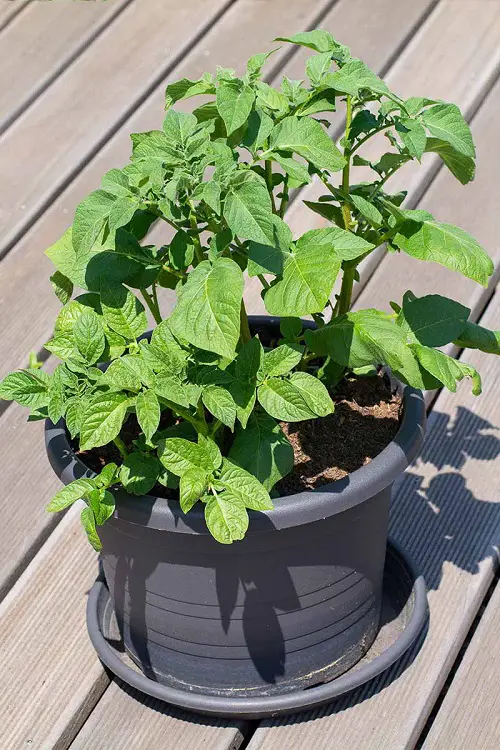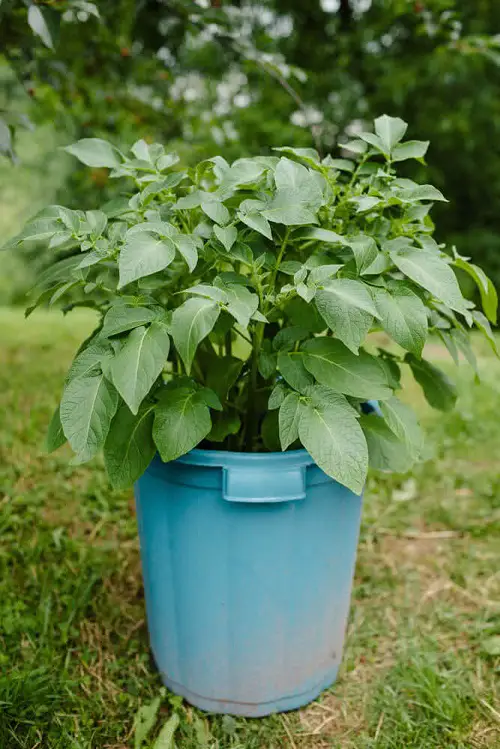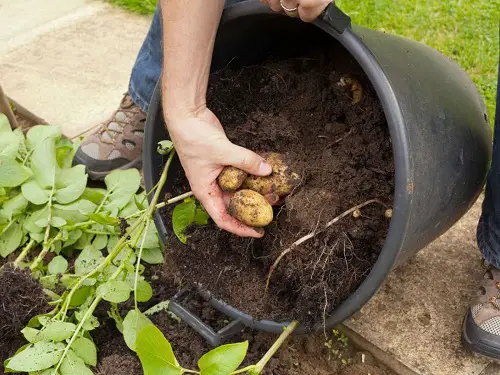Growing Potatoes in Containers is great if you are short on space. Cultivate a lot of them in a limited space with a little effort!

Growing Potatoes in Containers is easier than you think. All they need is a little extra care to produce a good harvest. If you too want to enjoy these tasty veggies, learn How to Grow Potatoes in Pots!
Learn how to grow potatoes from store-bought potatoes here
Potato Plant Profile
Potatoes are a popular vegetable and take an essential spot in almost every cuisine globally. It grows as underground tubers on herbaceous annuals and can easily be cultivated in home gardens.
Botanical Name: Solanum tuberosum
Ideal Pot Size for Growing Potatoes

Potatoes need a large container for the tubers to spread well. You can go for pots that are 10-14 inches wide and 12-18 inches deep for the best growth. You can also use burlap bags, wooden barrels, or fruit crates. Ensure the container has a drainage hole at the bottom.
The general rule of thumb is—the more space, the more harvest you can get. So, it is wise to get as big containers as you can manage to grow potatoes.
Check out the best ways to grow potatoes here
Propagating Potatoes

Potatoes are propagated via vegetation reproduction—the axillary buds on the surface of the potatoes.
- Gather some potatoes with eyes—axillary buds. New plants grow from these spots.
- Cut the potatoes in a way that each piece has 2-3 buds in them. Leave them in a dry spot to let them callous over for a day or two.
- Now fill 5-6 inches of the container with a nutrient-rich potting mix.
- Place 3-4 pieces in a 20-inch wide container with the growth nodes facing upwards.
- Cover them with 2-3 inches of soil.
- Locate the container at a place that receives 5-6 hours of bright direct sunlight and keep the soil evenly moist.
You’ll find new plants sprouting out in about a week.
Avoid these mistakes while propagating plants
Hilling of Potatoes
The key to growing more potatoes in containers lies in this step. Hilling is the method of piling up soil enriched in the organic matter around the seedlings to boost the growth of the underground tubers, i.e., the potatoes.
Once the seedlings grow 6-8 inches tall, aerate the soil around them and add 1-3 inches of a nutrient-rich medium. Repeat this process until the soil level reaches the pot surface. This will allow the plant to produce more potatoes, that too in a limited space.
Requirements for Growing Potatoes in Pots

Sunlight
Potatoes need a minimum of 6-7 hours of sunlight daily. The more light they will get, the better the harvest will be. Avoid keeping the plant in the shade as it will result in leggy growth and limited to no potatoes.
Soil
Potatoes grow well in nutrient-rich, well-draining soil with a pH of 6-6.5. Amend the growing medium with plenty of manure or compost to add micronutrients.
Remember, if the soil is not well-draining, it will result in diseased tubers.
Water
It is essential to keep the soil slightly on the moist side. This will prevent the plant from forming hollow potatoes. Soak the growing medium thoroughly, once or twice a week.
Keep an eye on the topsoil, and never let it dry out completely.
Here’s all you need to know about growing sweet potatoes
Potato Plant Care

Fertilizers
Potatoes in pots demand more fertilizer. Enrich the medium with plenty of organic matter at the time of planting. Later, use a balanced liquid fertilizer, diluted to 1/2 of its strength, once in 3 weeks.
While hilling the potatoes, you can mix egg shells, banana peels, and fish emulsion for an added boost.
Pests and Diseases
Potatoes are generally infested by potato bugs, blights, warts, or charcoal rot. Spray the plant with insecticidal soap or neem oil solution to keep them at bay.
Avoid overwatering and grow the plant in full sun with good air circulation to keep most diseases away.
Learn how to grow sweet potatoes at home here
Harvesting Potatoes

Potatoes get ready for harvest 70-90 days from planting. Wilting or drying out stems indicates that your potatoes are ready for harvest.
Gently dig the soil, and pull out the potatoes manually. Be careful not to hurt them in the process, and enjoy a plateful of this tasty homegrown.
You can also eat its leaves after stir-frying or sautéing and adding them to salads. They taste best when fresh.



Very good article.
Make sure to water deeply by waiting until water runs out the bottom. It is counterproductive to just water the surface of the soil. The nice thing about containers is that you can visibly see when you ve watered deeply enough. Simply watch for water to seep out of the container s bottom, and you ll know that they have a sufficient amount of water.
Potatoes are in the nightshade. THE LEAVES AND STEMS ARE POISONOUS! Recommending people to eat them is stupid!!!!!!!!!!!!!